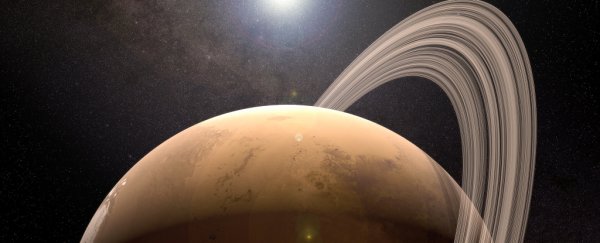Mars - glorious, dusty, complex Mars - may once have been even more dazzling. New research provides even more evidence that a rubbly ring once circled the Red Planet.
The new clue lies in Deimos, the smaller of the two Martian moons. It's orbiting Mars at a slight tilt with respect to the planet's equator - and this could very well be the result of the gravitational shenanigans caused by a planetary ring.
Ring systems aren't actually all that uncommon. When you think about ring systems, your mind immediately leaps to Saturn, no doubt - but half the planets in the Solar System have rings, Saturn, Uranus, Neptune, and Jupiter. Dwarf planet Haumea, and centaurs Chiron and Chariklo also have rings.
In 2017, a pair of researchers theorised that Mars, too, once had a ring. They conducted simulations of the larger of the two Martian moons, Phobos, and found that it could have formed after an asteroid slammed into Mars, sending debris flying into space, forming a ring that then clumped together into an earlier form of Phobos that was much more massive than it is today.
Now this new research has added Deimos into the mix - and the findings are in total agreement with the previous model.
"The fact that Deimos's orbit is not exactly in plane with Mars's equator was considered unimportant, and nobody cared to try to explain it," said astronomer Matija Ćuk of the SETI Institute.
"But once we had a big new idea and we looked at it with new eyes, Deimos's orbital tilt revealed its big secret."
Deimos' orbital tilt isn't huge - just 1.8 degrees off Mars' equator. Aside from that, its orbit is pretty normal - it swings around Mars every 30 hours or so, with extremely low eccentricity - so you can see why no one thought anything screwy was going on.
But there is something screwy going on with Phobos. It's much closer to Mars, on an orbit of 7 hours and 39 minutes, and it's getting closer to Mars by 1.8 centimetres a year.
Within 100 million years, it's expected that Phobos will reach the Roche limit, the distance from Mars at which the planet's tidal forces tear the moon apart.
Much of the debris could form a ring that rains down on Mars; but some of it could re-form into a smaller, newer Phobos that gets pushed outwards as the ring is pulled in.
This, according to the 2017 research, could have happened several times in the past. And this is where Deimos comes in.
Using numerical simulations, Ćuk and his team attempted to model how such an outward-moving proto-Phobos would have affected Deimos' orbital inclination. And they arrived at a proto-Phobos 20 times the moon's current mass, which would have entered a 1:3 orbital resonance with Deimos at a distance of 3.3 Mars radii that pushed the latter's orbit into a slight tilt.
This neatly produced the Deimos orbit we see today, which then remained relatively unchanged for billions of years.
This had to have taken place, Ćuk said, after the Late Heavy Bombardment of asteroids around 3.9 billion years ago, which likely would have destroyed Deimos; afterwards, the moon would have reassembled, but at zero (or close to) inclination. But it also can't have occurred too much after, because the proto-Phobos-Deimos resonance requires low inclination at the start.
"Something like 3.5 billion years ago is our best bet," he told ScienceAlert. "That agrees beautifully with Hesselbrock and Minton calculation on when Mars had an inner moon with 20 times the mass of Phobos."
That probable destruction of and reformation at low inclination of Deimos also means the asteroid bombardment is unlikely to have caused the disruption to the moon's orbit. And an asteroid that flew by would have disrupted both inclination and eccentricity. Since Deimos' eccentricity is crazy low, that's unlikely too.
As for proto-Phobos, it would have been gravitationally smushed by Mars again.
"Once the ring was gone, the moon also started falling because of Martian tides (just like Phobos)," Ćuk told ScienceAlert.
"Once it was too close to Mars, tidal forces would pull it apart into a new ring, and the cycle would repeat, probably twice, to get to Phobos that we see."
That means current Phobos probably formed around 200 million years ago - and that's something scientists can use to test the theory.
The Japanese space agency, JAXA, is planning to send a probe to Phobos in 2024. This probe will collect surface samples and bring them to Earth.
Those surface samples could then be dated to estimate the age of Phobos' surface. If it's no more than a couple of hundreds of millions of years old, that would validate the team's prediction.
The research has been presented at the 236th Meeting of the American Astronomical Society, and accepted into The Astrophysical Journal Letters. It is currently available on arXiv.
